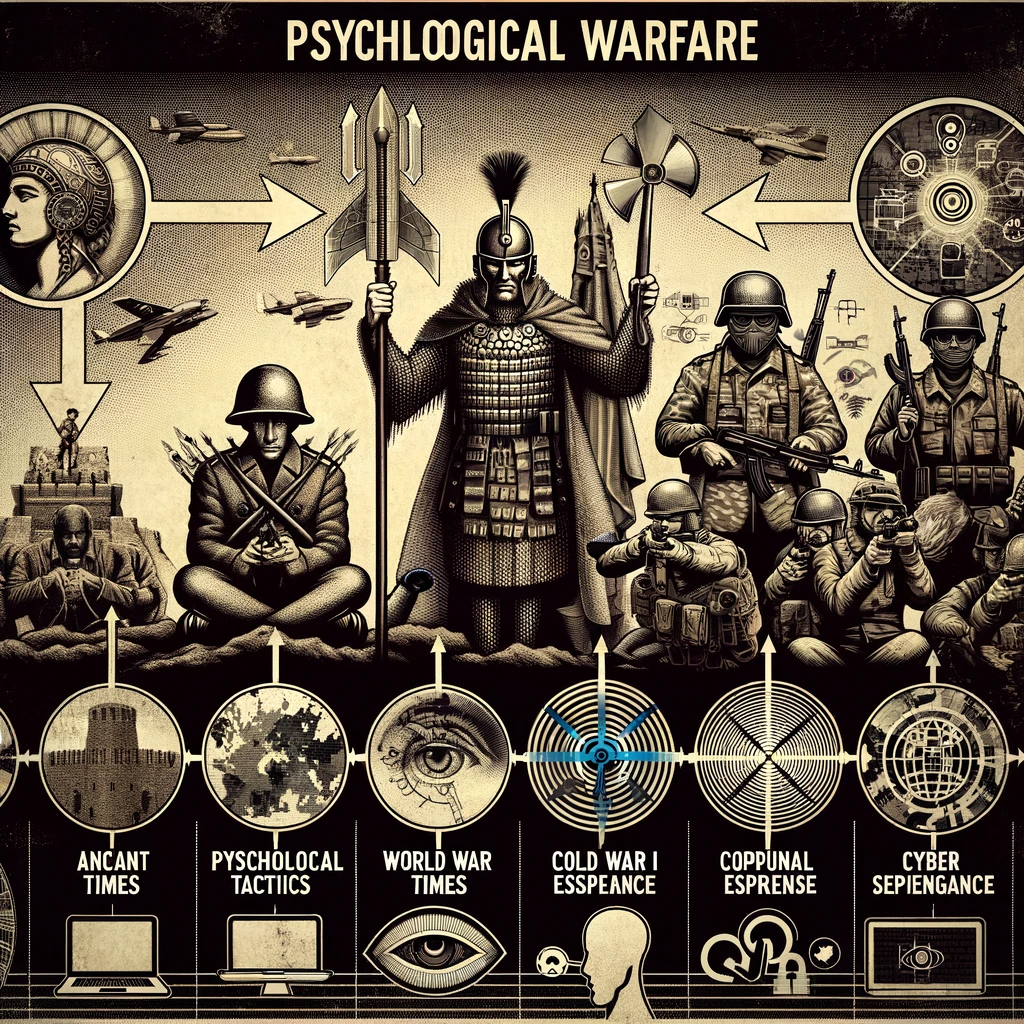Psychological Warfare Tactics: Historical Analysis and Modern Applications
Psychological Warfare Tactics: Historical Analysis and Modern Applications
Psychological warfare, a stratagem used throughout history, manipulates adversaries’ psychological states to achieve military objectives. This sophisticated form of warfare extends beyond the battlefield, influencing political, social, and economic realms. This article delves into the historical evolution of psychological warfare tactics and their modern applications, illustrating their significant impact on contemporary conflicts and global politics.

Historical Evolution of Psychological Warfare
Psychological warfare dates back to ancient civilizations, where psychological manipulation was employed to demoralize enemies and gain strategic advantages. Sun Tzu’s “The Art of War,” written around 500 B.C., underscores the importance of psychological strategies in warfare, advocating for the use of deception, misinformation, and fear to weaken opponents’ resolve (Sun Tzu, n.d.). Ancient Greek and Roman militaries also integrated psychological tactics, using propaganda, threats, and misinformation to destabilize enemy morale.
The Middle Ages saw the continuation of these practices, with psychological warfare becoming more systematic. Siege warfare often involved psychological elements, such as catapulting diseased corpses over city walls to spread fear and disease among the besieged population. During the Crusades, psychological warfare played a significant role in shaping perceptions and justifying military actions on religious grounds.
In the modern era, psychological warfare evolved with technological advancements. World War I witnessed the use of propaganda posters and leaflets to influence public opinion and demoralize enemy troops. Radio broadcasts and film propaganda became prevalent in World War II, exemplified by Tokyo Rose and Lord Haw-Haw, who broadcast demoralizing messages to Allied troops (Doherty, 1995).
The Cold War era marked a significant shift, with psychological warfare becoming a key element of statecraft. The United States and the Soviet Union engaged in extensive propaganda campaigns, disinformation, and covert operations to sway global opinion and undermine each other’s influence. The use of psychological tactics in the Vietnam War, such as the strategic use of music and leaflets to demoralize Viet Cong forces, further illustrates the evolving nature of psychological warfare (Cummings, 2009).
Modern Applications of Psychological Warfare
In the contemporary context, psychological warfare has adapted to the digital age, with cyber warfare and information operations becoming central components. The use of social media, fake news, and targeted disinformation campaigns to manipulate public opinion and destabilize societies exemplifies modern psychological warfare tactics.
The Russian interference in the 2016 U.S. presidential election, through a coordinated disinformation campaign on social media platforms, highlights the potency of these tactics in shaping political outcomes (Mueller, 2019). Similarly, the Islamic State (ISIS) has effectively used social media for propaganda and recruitment, demonstrating how non-state actors leverage psychological tactics in asymmetrical warfare (Farwell, 2014).
Governments and military organizations now prioritize information operations and psychological operations (PSYOP) as key components of their strategic arsenal. The U.S. military’s use of PSYOP in Iraq and Afghanistan, involving leaflet drops, radio broadcasts, and social media campaigns, aimed to influence local populations and undermine insurgent groups (Coll, 2018).

Conclusion
The historical evolution and modern applications of psychological warfare tactics reveal their enduring relevance and adaptability. From ancient battlefields to digital domains, these tactics continue to shape conflicts, political landscapes, and societal perceptions. Understanding the dynamics of psychological warfare is crucial for comprehending contemporary global events and formulating effective responses to emerging threats.
Frequently Asked Questions (FAQs)
Q1: What is psychological warfare?
A1: Psychological warfare is a tactic used in conflicts to influence, manipulate, or alter the psychological state of an adversary to achieve military, political, or strategic objectives.
Q2: How has psychological warfare evolved over time?
A2: Psychological warfare has evolved from ancient practices of deception and demoralization to modern techniques involving social media, disinformation, and cyber operations.
Q3: What role did psychological warfare play in World War II?
A3: In World War II, psychological warfare involved the use of propaganda, radio broadcasts, and film to influence public opinion and demoralize enemy troops.
Q4: How do modern governments use psychological warfare?
A4: Modern governments use psychological warfare through information operations, social media campaigns, and cyber tactics to manipulate public opinion and achieve strategic objectives.
Q5: Can non-state actors employ psychological warfare?
A5: Yes, non-state actors like terrorist organizations use psychological warfare, particularly through social media and propaganda, for recruitment and to spread their ideologies.
For More Information:
- The Art of War by Sun Tzu
- Propaganda and Psychological Warfare Studies
References
Coll, S. (2018). Directorate S: The C.I.A. and America’s Secret Wars in Afghanistan and Pakistan. Penguin Press.
Cummings, E. M. (2009). The use of music in psychological operations. U.S. Army Field Manual.
Doherty, T. (1995). Projections of war: Hollywood, American culture, and World War II. Columbia University Press.
Farwell, J. P. (2014). The media strategy of ISIS. Survival, 56(6), 49–55.
Mueller, R. S. (2019). Report on the Investigation into Russian Interference in the 2016 Presidential Election. U.S. Department of Justice.
Sun Tzu. (n.d.). The Art of War (Samuel B. Griffith, Trans.). Oxford University Press. (Original work published 5th century BC)

